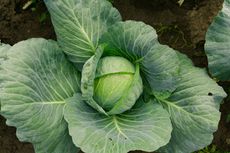Vegetables
There’s nothing quite as good as eating home grown veggies from the garden. While growing garden vegetables may seem daunting at first, learning how to grow vegetables yourself shouldn’t be intimidating. Most vegetable plants are easy to grow, and there are numerous types of vegetables that can be grown to satisfy even the pickiest of eaters. Here you can learn everything from starting vegetable seeds and caring for vegetable plants throughout the season to harvesting your crops and storing them once it’s come to an end.
Explore Vegetables
Vegetables
-
What Is A White Queen Tomato – Tips For Growing White Queen Tomatoes
Something you learn very quickly when growing tomatoes is that they don't just come in red. One of the most impressive white varieties you can find is the White Queen cultivar. Click here to learn how to grow a White Queen tomato plant.
By Liz Baessler
-
What Is A Black Ethiopian Tomato: Growing Black Ethiopian Tomato Plants
Tomatoes aren't just red anymore. Black is one criminally underappreciated tomato color, and one of the most satisfying black tomato varieties is the Black Ethiopian. Keep reading to learn more about growing Black Ethiopian tomato plants in the garden.
By Liz Baessler
-
Red October Tomato Care – How To Grow A Red October Tomato Plant
Nothing at the supermarket can compare to the freshness and taste you get from homegrown tomatoes. There are many varieties you can grow, but if you want a tasty tomato that will keep well, try the Red October. Click this article to learn more.
By Mary Ellen Ellis
-
Southern Pea Cotton Root Rot – Treating Texas Root Rot Of Cowpeas
Are you growing cowpeas or southern peas? If so, you'll want to know about Phymatotrichum root rot, also known as cotton root rot. For information about cowpea cotton root rot and its control, this article will help.
By Teo Spengler
-
Southern Pea Root Knot Nematode: Managing Root Knot Nematodes On Southern Peas
Southern peas with root-knot nematodes can suffer in multiple ways. The pathogen can damage the plants enough to reduce the harvest, but it can also make your peas vulnerable to other infections, including fungal and bacterial diseases. Learn more here.
By Mary Ellen Ellis
-
What Is Pea Aphanomyces Disease – Diagnosing Aphanomyces Root Rot Of Peas
Aphanomyces rot is a serious disease that can affect pea crops. If unchecked, it can kill small plants and cause real growth problems in more established plants. Learn more about aphanomyces root rot of peas and how to manage the disease here.
By Liz Baessler
-

Gonzales Cabbage Plant Info – How To Grow Gonzales Cabbage
: Gonzales cabbage variety is a green, early season hybrid that produces mini heads and takes 55 to 66 days to mature. The firm, softball-size heads mean less waste. They are a perfect size for most family-size cabbage meals and have a sweet, spicy taste. Learn more here.
By Susan Albert
-
Powdery Mildew Of Parsnips – Treating Signs Of Powdery Mildew In Parsnips
Powdery mildew is a very common disease that affects a wide array of plants. Powdery mildew of parsnips can be a problem if left unchecked too. To learn more about how to manage and recognize the symptoms of powdery mildew in parsnips, click here.
By Liz Baessler
-
Pea Powdery Mildew Treatment: Controlling Powdery Mildew In Peas
Powdery mildew is a common disease that afflicts many plants, and peas are no exception. Powdery mildew can cause a variety of problems, including stunted or distorted growth, decreased harvest and small, flavorless peas. Find more information here.
By Mary H. Dyer
-

What Is Bunchy Top Virus Of Tomato Plants
Bunchy Top Virus of tomatoes may sound like a funny disease, but it's no laughing matter. Find out how to detect Bunchy Top and what you can do about it in this informative article. The health of your tomato plants may depend on it.
By Kristi Waterworth
-
Illinois Beauty Info: Caring For Illinois Beauty Tomato Plants
The Illinois Beauty tomatoes that may grow in your garden are heavy producers and originated through an accidental cross. These tasty heirloom, open-pollinated tomato plants are excellent for those that might save seeds too. Learn more about growing these tomatoes here.
By Becca Badgett
-
Radish Cercospora Management: Treating Cercospora Leaf Spots On Radish Leaves
Cercospora leaf spot of radish can cause seedling death or, in older plants, reduce the size of the edible root. The disease is harbored in soil and in cruciferous plants. Learn about radish Cercospora management and what you can do to prevent the disease here.
By Bonnie L. Grant
-
Potato Charcoal Rot: Learn About Charcoal Rot In Potato Plants
Potato charcoal rot is unmistakable. The disease also hits several other crops where it decimates the harvest. Only certain conditions cause activity of the fungus responsible, which lives in soil. Click this article for some tricks to protect your potato crop.
By Bonnie L. Grant
-

11 Edible Plants For A Year-Round Garden In A Bucket
Want to know how to grow food inside your house and which foods do best indoors? Click here to learn all about it.
By Bonnie L. Grant
-

Kabocha Squash Growing Tips – Learn About Kabocha Squash Pumpkins
Kabocha winter squash pumpkins are smaller than pumpkins but can be used in much the same way. Read on to learn how to grow kabocha squash.
By Amy Grant
-

Early American Vegetables - Growing Native American Vegetables
As a gardener, did you ever wonder which native American vegetables were cultivated and consumed in pre-Columbian times? Let's find out what these vegetables from the Americas were like.
By Laura Miller
-

Ancient Vegetables And Fruits - What Were Vegetables In The Past Like
How different were vegetables in the past? Let's take a look. The answer may surprise you!
By Laura Miller
